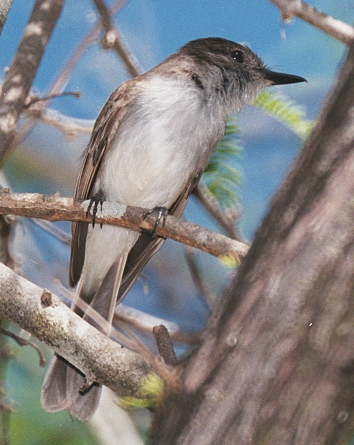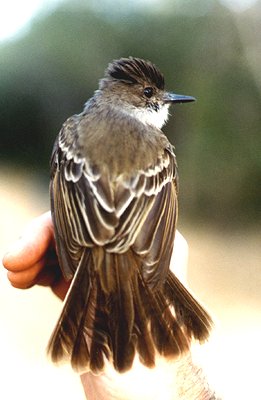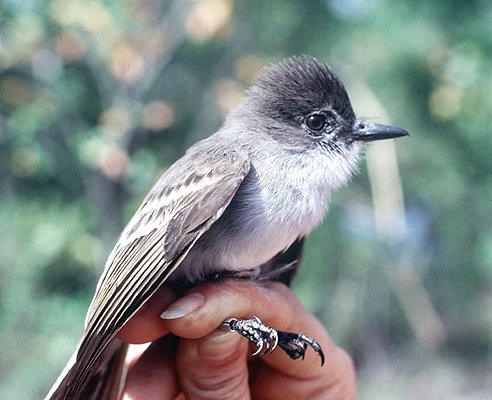|
Puerto Rican Flycatcher Myiarchus antillarum Juí, |
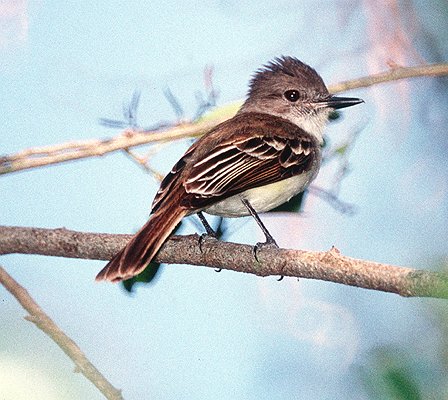 |
|
Photo: M. Oberle
|
|
IDENTIFICATION: A flycatcher with a dark brown back and light undersides. There is sometimes a slight hint of two faint, buff wing bars. Length: 18-20 cm.; weight: 23 g. VOICE: The common song is an ascending whistle, reflected in its common name in Spanish, "Juí." It calls frequently throughout the day in the breeding season. Like many other flycatcher species, the Puerto Rican Flycatcher has a more complicated, beautiful "dawn song" that it gives early in the day. Audio 2 (M. Oberle). HABITAT: Shade coffee plantations and lower elevation forests, especially in coastal scrub forests. HABITS: The Puerto Rican Flycatcher is well camouflaged as it sits on branches in the lower and middle level of the forest, waiting to fly out after insects. Prey include flies, weevils, caterpillars, bees, wasps, dragonflies, and hemipteran insects, but about 15% of the diet consists of wild fruit and berries. Snails, lizards and frogs are occasionally eaten. The flycatcher’s jaws have ligaments that reflexively snap shut when the bird grabs an insect in mid-air. It nests from February to July in a tree hole or nest box. Clutches range from 3-6 yellowish eggs with brown spots. Both the male and female incubate the eggs. Unlike many other landbirds, the male develops a brood patch just like the female (the brood patch is an area of reduced or absent feathers on the belly to efficiently transfer heat while incubating eggs). Young fledge about 15-16 days after hatching. STATUS AND CONSERVATION: Common, but sometimes hard to see outside the breeding season when it is less vocal. After a major hurricane in 1928, the population dropped dramatically. It was not recorded from the Virgin Islands until the mid-20th Century, but the range expansion there might reflect a re-colonization after native forests recovered from centuries of intensive sugarcane farming. Biaggi relates that campesinos believed the Puerto Rican Flycatcher delivered warnings of good or bad occurrences. The Puerto Rican Flycatcher readily uses artificial nest boxes. RANGE: Endemic to Puerto Rico and the Virgin Islands. Regular locations to find this species include Boquerón, Vega, and Guánica state forests. TAXONOMY: PASSERIFORMES; TYRANNIDAE; Tyranninae. This species was formerly lumped by taxonomists with the Stolid Flycatcher (Myiarchus stolidus) of Jamaica and Hispaniola, the LaSagra’s Flycatcher (Myiarchus sagrae) of Cuba and the Bahamas, and the Lesser Antillean Flycatcher (Myiarchus oberi) which breeds from Nevis to Saint Lucia. Three other species in this genus are endemic to other islands in the Caribbean: the Sad Flycatcher (Myiarchus barbirostris) and Rufous-tailed Flycatcher (Myiarchus validus) of Jamaica, and the Grenada Flycatcher (Myiarchus nugator) which breeds from Grenada to Saint Vincent. |
|
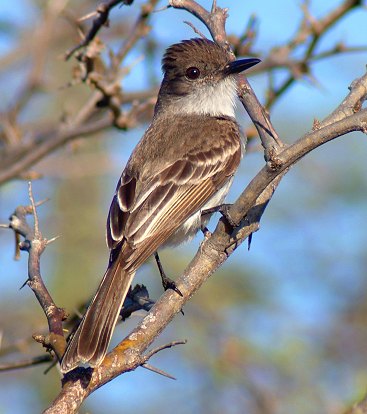 |
|
Photo: R. Rodríguez Mojica
|
 |
|
|
Photo: M. Oberle
|


